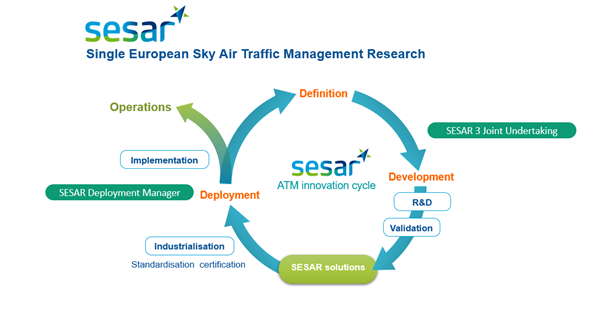SESAR and the Single European Sky
The SESAR (Single European Sky ATM Research) Project is the technological pillar of the EU’s SES initiative aiming to modernise Europe’s air and ground ATM infrastructure and operational procedures. SESAR defines, develops and deploys interoperable ATM solutions aiming to optimise the management of air traffic so that airspace users can fly safely the most efficient trajectories and that new flying vehicles (such as drones) are safely integrated in all classes of airspace.
State of play
SESAR is a joint effort driven by the EU, EUROCONTROL and a wide range of public and private, civil and military aviation stakeholders. Together, the SESAR partners cooperate and coordinate their resources to define, develop, validate and deploy innovative technological and operational ATM solutions with the goal to achieve the Digital European Sky.
To facilitate and accelerate the implementation of essential ATM functionalities based on SESAR solutions, the Commission set up the SESAR deployment framework (Commission Implementing Regulation (EU) No 409/2013) that relies on three main instruments:
1) Common projects
2) The SESAR deployment governance
3) The SESAR Deployment Programme
The SESAR Deployment Framework, which mandates the synchronised deployment of basic ATM functions based on SESAR solutions, completed its pilot phase, which included the adoption of the first common project (the ‘Pilot Common Project’), the appointment of a SESAR Deployment Manager and the approval of the first SESAR Deployment Programme.
After reviewing the progress of the Pilot Common Project, the Commission adopted the Common Project One (CP1). The SESAR Deployment Programme was also updated accordingly and in July 2022, the Commission appointed a new SESAR Deployment Manager under a new mandate up to the end of 2027.
In terms of policy priorities, the SESAR 3 R&I activities focus on achieving the ‘Digital European Sky’ through technologies that can help reduce emissions, increase the levels of automation, cyber-secure data sharing and connectivity in ATM, virtualisation of the ATM infrastructure and air traffic service provision in all types of airspace, including for very low and high-altitude operations. They will also include the ‘Digital Sky Demonstrators’ to validate, more widely, new concepts in real operational environments, thus facilitating the timely deployment of SESAR solutions also thanks to an accrued stakeholder buy-in.
The digital European sky was first proposed by the SESAR Joint Undertaking in 2017, and then further detailed in 2019 in a commonly agreed roadmap by stakeholders from across the aviation community. This vision leverages the latest digital technologies to transform Europe’s aviation infrastructure enabling it to handle the future growth and diversity of air traffic safely and efficiently, while minimising environmental impact. To bring the maximum benefits, the digital transformation will be holistic and passenger-centric, covering air travel door-to-door and involving everyone that plays a role in that experience, from the airports, airlines and air navigation service providers, to the regulatory, standardisation and safety bodies.


